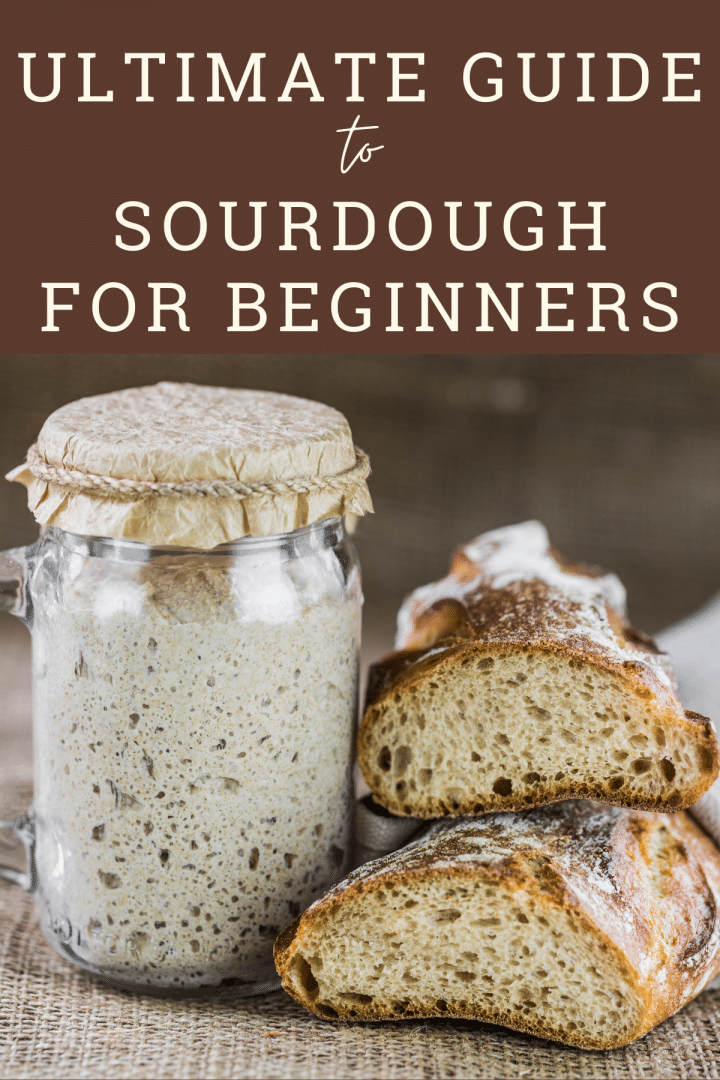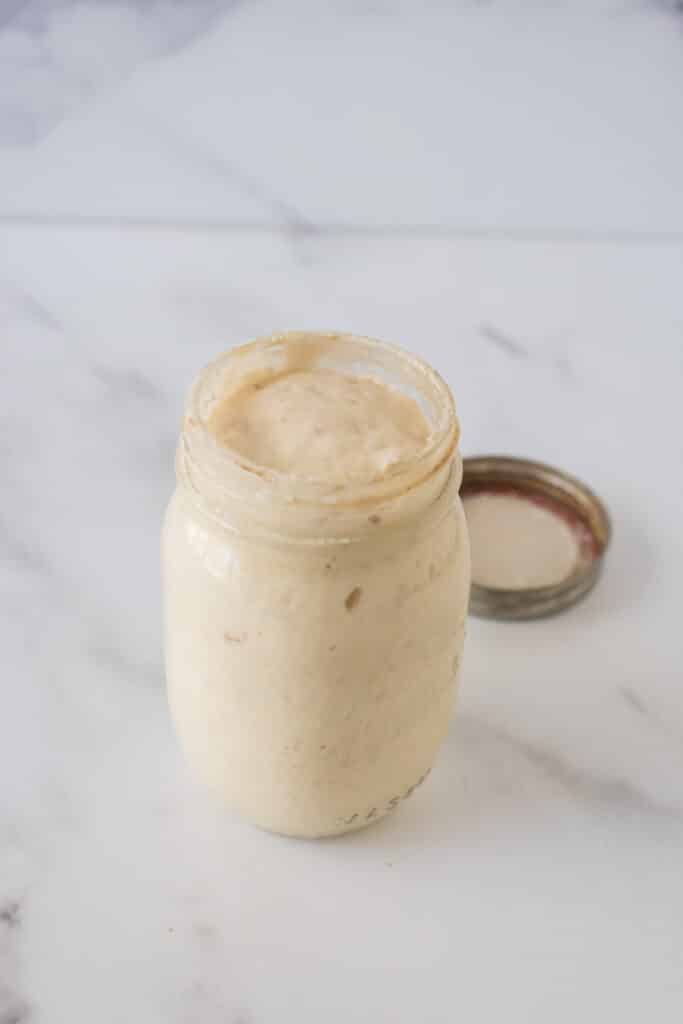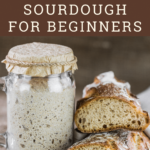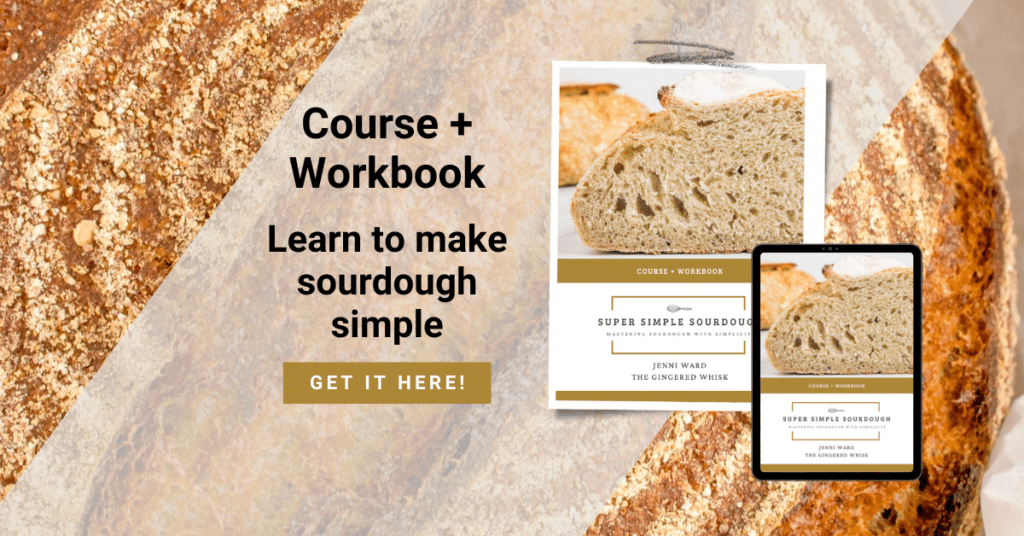Sourdough for Beginners
The ultimate guide to sourdough for beginners! Using a sourdough starter is a fun and delicious hobby, but it shouldn’t feel like rocket science. Sourdough can be easy, and this guide will help you understand all the different aspects.

Keeping a sourdough starter is a fun combination of a hobby that’s also almost like having a pet.
Yes, sourdough can seem overwhelming and complicated, especially when you’re getting started with it. The cool thing about sourdough is that you can make it as complicated and technical as you want – or you can keep it easy and simple. Personally, as a work-from-home mom with three young girls and a menagerie of pets, I like simple.
I like my sourdough to be a fun and easy pastime, and I don’t want to do crazy complicated math or be tied to the kitchen for hours on end to get great results I can brag about. And I like to push the boundaries of where I can use my starter, too! (It’s not just loaf after loaf of bread around these parts, friend.)
I hope this guide on sourdough for beginners will help you understand more about how sourdough works, as well as feel confident in your ability to use it.
What is sourdough?
Sourdough is a strain of wild yeast. Yeast is a type of fungus, and we use it in baking….. Yeasted bread can be made two ways – with commercially produced yeast (like fast active yeast) or with a natural or wild starter (aka, sourdough!). Commercial yeast comes in a dried form at the grocery store and has been cultivated in a lab to quickly leaven our bread. Sourdough is a wild and natural strain of yeast that has a more sour taste and takes longer to leaven our baked goods.
Why should you want to use sourdough?
Sourdough is a fun way to add yeast leavening to many recipes. It is also a really fun way to add great depth of flavor to many recipes, even recipes that don’t normally use yeast.
Mostly, you should use sourdough because its fun and delicious!
What does sourdough taste like?
Sourdough bread is made with a culture of natural yeasts that contains different strains of yeast and bacteria. Because if ferments longer than commercially produced yeast, it produces a more flavorful bread. It does have a more sour taste to it, but the level of sourness can be controlled during the baking process.
And because the strains of yeast and bacteria differ based on the air around you and the flour you use, each sourdough starter can taste a little different.
Is sourdough bread healthy?
Many people find that sourdough breads (and baked products made with sourdough starter) are easier to digest due to the fermentation of the flour. I am not a dietician, and I do not make health claims on this site, so you will need to do your own research and decide for yourself.
Is sourdough difficult?
This is a common misconception. Sourdough is not difficult or fussy. It is different than using commercial yeast because there are more factors to think about. Generally, it takes more time to rise than a commercial yeast recipe because the natural yeasts in sourdough take longer to act.
However, the cool thing about sourdough is that you can make it as technical and complex as you want and create some truly awesome recipes with it. Or you can keep it simple and make great things, too! The choice of how you use your starter is yours! It is so fun to see how you can use your starter.

Sourdough starters
A sourdough starter is a natural culture of yeast that is used to leaven bread. Called poolish, biga, levain, and mother culture, it usually contains flour and water mixed together.
Natural yeasts and bacteria live everywhere – including in your flour and in the air. When the yeast and bacteria are fed flour and water, they become active and start to feed on the starches in the flour. That produces fermentation, which creates CO2, gases, acids, and alcohol.
As the starter is fed again and again, the culture becomes stronger, collecting more yeast and bacteria from its surroundings, and it eventually becomes strong enough to leaven bread.
How to make a sourdough starter
Making a sourdough starter is not challenging! It only takes some flour, water, and patience!
The patience part is the hardest because it takes about 2 weeks for a sourdough starter to become fully active and ready to use to make bread.
If you don’t want to make a starter from scratch, you can purchase a dried form online through King Arthur Flour to activate, or find someone you know who has a starter and beg some from them.
Need a starter? Learn how to make a sourdough starter.
How to feed your sourdough starter
There are as many ways to feed your sourdough starter, as there are ways to feed yourself! Hydration rates, flours, and methods, everyone has their own method they like.
The best place to start is a 100% hydration, which means there is an equal amount of water and flour in your starter. It typically has the consistency of muffin batter.
There are other hydrations of starters, too. A lower hydration starter is thicker and has less water to flour ratio and has a really thick, almost cookie dough consistency. A higher hydration starter has more water than flour, and has an almost pancake batter consistency. You can use different hydrations of starter to make different things – like for sourdough challah you use a 50% stiff hydration.
How often you feed your starter depends on where you keep it. If you will bake with your starter often and you keep it on your counter, it needs to be fed every 12 hours. If you only bake with your starter occasionally and you keep it in the fridge, you can feed it once a week.
You can read more about exact details on how to feed your sourdough starter and what you need to do to maintain it, as well as lots of FAQ’s in my detailed guide.
What is sourdough discard?
Sourdough “discard” really has an unfortunate name as it implies that there is something undesirable about it. The fact is, discard is just a name for your inactive and unfed sourdough starter.
When you feed your starter, you are essentially doubling the amount you have. You don’t want to create a massive, ever increasing amount of starter, because it would eventually take over your house.
What do you do with sourdough discard?
You can either use your unfed discard as is, straight out of the jar in a simple recipe. This is typically called “unfed” or “inactive” or sometimes just straight “discard”. In these recipes, you aren’t really using the natural leavening power of your sourdough yeast, because they are in an unfed and dormant state. These recipes are usually quick and contain either baking powder, baking soda, or both. They are simple and easy ways to use your discard without throwing it away, and a simple way to add sourdough flavor to baked goods.
Check out these easy sourdough discard recipes for more ways to use your discard.
Is sourdough just for bread?
No! You can do so much with your sourdough starter! I love making sourdough dessert recipes – the yeast and lactic acid found in the starter adds so much depth of flavor and improves the texture of so many recipes!
Or you can feed the discard, wait for it to become fully active, and use it in a recipe. This is often called “fresh starter” or “active starter” in recipes.
If you can’t bake with your discard on feeding day, you can place your discard in a jar in the fridge for another few days (but don’t leave it in there too long, those yeasties are hungry!) or you can, sadly, decide to throw it away. Don’t throw it away because you are short on time, check out Quick Sourdough Recipes for quick and easy recipes you can make when short on time!. Another great use of sourdough is in delicious breakfast recipes with sourdough.
Pro Tip: If you’re tossing your discard, make sure it ends up in the trash, though, and not down the drain. When strater dries, it tends to turn into cement, and you don’t want that in your drains!
What tools and equipment do you need to make sourdough?
Sourdough doesn’t require many specialized products to use. There are a few things you need to make keeping and using your sourdough starter easier. At the very least, you need a jar to keep it in.
Other tools you use depend on what kind of recipes you are creating with it. Simpler recipes require items you probably already have on hand – mixing bowls, rolling pins, a mixer, etc.
One item I do recommend everyone who uses sourdough to own is a scale to measure out flour and water with. This is especially handy for feeding your starter.
More advanced technical sourdough bread baking recipes do require different tools that you might need, but that depends on each recipe.
Read more about essential sourdough tools and equipment in my guide.
Should you keep multiple versions of a starter?
A lot of places offer to sell you portions of older sourdough starters, claiming they are hundreds of years old and have unique flavors. However, once those starters come into your house, breathe your air, and are fed your flour, it will change into starters that are similar to each other.
You can choose to keep multiple versions of a starter if you feed each starter with a different kind of flour (for example one whole wheat starter and one rye starter).
How to make sourdough bread
There are many different kinds of sourdough bread you can make. Recipes can be simpler or more advanced, depending on the outcome you are looking for. I recommend starting with bread recipes that call for a 100% hydration starter and a simpler recipe like this whole wheat sourdough bread. Another good choice is this sourdough sandwich bread.
What else can you do with sourdough?
Sourdough starters aren’t just for bread! You can do SO MUCH with sourdough! Sourdough is great for desserts and other recipes
Browse my recipe archive page for over 60+ easy sourdough recipes.
Want to learn more? Take my easy 30 day Simple Sourdough Course
Beginner Recipes that use unfed, inactive sourdough starter discard:
Beginner recipes that use fed, active sourdough starter discard:
Intermediate Sourdough Recipes that use active sourdough starter



I’m using organic unbleached all purpose flour. My first attempt wasn’t fermented after a week. I did a little research and it may have been because I was using reverse osmosis water so I started over using tap water. I prefer not to drink our water, but it isn’t the worst tap water. It’s been t days and there are barely any bubbles. I can see a few on the side of the jar, but nothing on top. I’m not new to cooking, but this is my first try at a sourdough starter. I have a coffee filter covering the top (of the glass jar) and it’s sitting on my counter. I’d appreciate any help you can offer.